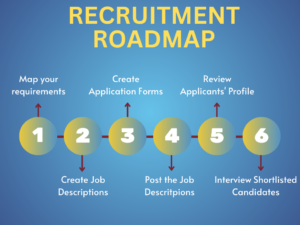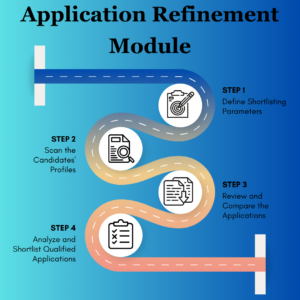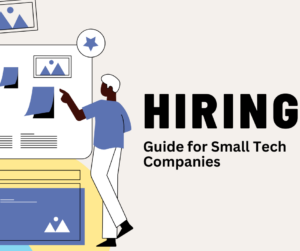Introduction
Recruitment is not an overnight task, especially when it comes to small companies. You might have innovative ideas, an actionable plan, and a product with great potential, but with limited resources and infrastructure, you might struggle to find the right candidates for your tech operations.
However, with the right hiring strategies, small tech firms can overcome these obstacles and scale up successfully.
In this blog post, we’ll explore a roadmap that can help small tech companies recruit top tech talent with minimal resources.
The Current Small Business Scenario
As per a 2021 report published by Statistics Canada, 98.1% of all businesses in Canada were small businesses including micro businesses, employing 63.8% of the total workforce.
86% of these companies are actively investing in technology and 49% are deploying mobile apps to connect with their customers. This means you need to recruit a strong team of tech professionals to stay competitive.
6 Steps to Ensure Smart Hiring For Small Tech Firms

Step 1: Know What to Look For
Before diving into the recruitment process, it’s crucial to have a clear understanding of what qualities and qualifications want the candidate to possess.
Implementation Module:
- Outline the specific skills, experience, and qualifications needed for the role. Consider the duties, responsibilities, and goals of the position to determine the essential criteria.
- Assess your company’s culture and values. Look for candidates whose values align with your organization’s culture, as they are more likely to thrive and contribute positively to the team.
- Identify the key attributes that are non-negotiable for success. Whether it’s strong communication skills, problem-solving abilities, critical thinking skills, or leadership qualities, prioritize traits that are essential for the position.
- Analyze how the role may evolve in the future and what skills will be valuable in the long term. Seek candidates who not only meet the current requirements but also demonstrate potential for growth and adaptability.
Step 2: Write a Compelling Description
An effective job description is crucial for attracting the right candidates and ensuring a successful hiring process.
Implementation Module:
- Start with a clear and concise job title that accurately reflects the role. Add a summary outlining the main responsibilities and objectives of the position.
- List the primary duties and tasks the role entails. Use action verbs to describe responsibilities and be specific about expectations.
- Clearly outline the qualifications, skills, and experience necessary for the role. Differentiate between “must-have” and “nice-to-have” qualifications. Try including salary range and benefits offered to align with their expectations.
- Provide a brief overview of your company, its culture, values, and mission. This helps candidates understand the context of the industry, business goals, and job roles to assess if they align with the organization. Add a relevant call to action.
Step 3: Create a Form
Creating application forms for the applicants streamlines evaluation and ensures consistency in information collection.
Implementation Module:
- Begin by including fields for basic information such as name, contact details, and job history. This provides essential context for assessing a candidate’s competence and initiating communication.
- Tailor the application form to the specific requirements of the job by including questions that assess relevant skills, experience, and qualifications. Ask about education, certifications, relevant work experience, and specific job-related skills.
- Pose clear and specific questions that prompt concise responses. Structured questions make it easier to compare candidates objectively, assess their suitability for the role, and prevent complexities.
- Before finalizing the application form, test it to ensure it functions correctly and captures all necessary information. Gather feedback from hiring managers and other stakeholders to identify any areas for improvement and make adjustments accordingly.
Step 4: Post the Requirements
Posting your requirements across various platforms, including a company website, social media, and job boards, is crucial for maximizing exposure and attracting qualified candidates.
Implementation Module:
- Post the job vacancy on popular job boards such as Indeed, Glassdoor, and ZipRecruiter to reach a broader audience. Incorporate relevant keywords and phrases into your job description to improve visibility on search engines and job board platforms.
- Ensure the job posting is prominently displayed on your careers page, making it easy for visitors to find and apply. Consider adding a dedicated section for job openings and include information about your company’s values and culture.
- Share the posting on your company’s social media pages across LinkedIn, Twitter, and Facebook to reach a wider audience. Make sure that the posts are visually appealing and contain relevant hashtags and encourage employees to share them with their networks.
- Be active and consistent in answering inquiries and engaging with candidates who express interest in the position. Communicate our company’s culture and values, giving candidates a glimpse of what it’s like to work for your organization.
Step 5: Refine the Applications

Reviewing applications requires a systematic approach to assess qualifications, skills, and experience.
Implementation Module:
- Before diving into the received applications, you need to define key criteria based on the job description. This could include qualifications, relevant experience, technical skills, and cultural fit.
- Start by scanning resumes to quickly identify candidates who meet the basic qualifications and experience required for the role. Look for relevant keywords, education, and job titles to narrow down the pool.
- Review the forms to gain insights into candidates’ motivations, communication skills, qualifications, cultural fit, industry knowledge, and alignment with the company’s values. Look for personalized messages that demonstrate genuine interest in the role and company.
- Keep detailed notes and feedback on each candidate to facilitate discussions with hiring managers and ensure a fair and transparent selection process.
Step 6: Conduct the Interview
Finally, you need to schedule an interview round(s) to facilitate informed decision-making. You can enable a sleek process by following the following protocols.
- Prepare yourself with the candidate’s resume, cover letter, and any additional materials they provided. Prepare a list of structured interview questions tailored to the job requirements and company values.
- Start the interview by greeting the candidate warmly and introducing yourself and any other interviewers present. Set a relaxed tone to help candidates feel comfortable and encourage open communication.
- Briefly explain the interview format, including the types of questions you’ll be asking and the approximate duration of the interview. This helps candidates know what to expect and feel more at ease.
- Ask questions about candidates’ work preferences, values, and motivations to gauge their fit with the company culture and team dynamics. Look for alignment with the organization’s mission and values.
Key Takeaways
In conclusion, smart hiring strategies are essential for small tech companies poised for growth. You need to ensure that the roadmap is seamlessly implemented to get the best results. Establish a structured interview process, and leverage technology to automate repetitive tasks.
Additionally, you consider using applicant tracking systems (ATS) to manage candidate applications more efficiently and keep track of applicants throughout the hiring process. These approaches can enable you to identify and onboard top talent more quickly.
References:
https://www.elevatus.io/blog/small-businesses-hiring-on-budget/ https://www.linkedin.com/pulse/effective-hiring-practices-small-medium-size-don-previti-mk5te?utm_source=share&utm_medium=member_android&utm_campaign=share_via https://solutionscout.com/human-resources/hiring-employee-small-business/ https://zapier.com/blog/small-business-hiring/ https://smith.ai/blog/14-best-practices-for-hiring-employees-at-a-small-business https://www.knitpeople.com/blog/the-ultimate-guide-hiring-employees-in-canada https://www.linkedin.com/pulse/how-build-winning-tech-team-hiring-strategies-best-practices-goldar https://www.hyno.co/blog/how-to-hire-the-best-tech-team-for-your-start-up.html https://www.entrepreneur.com/growing-a-business/how-to-hire-a-great-tech-team/441434 https://testlify.com/how-to-hire-the-best-technical-talent-for-your-company/



